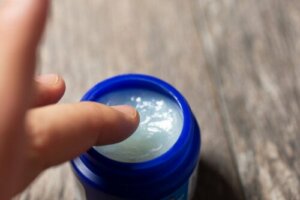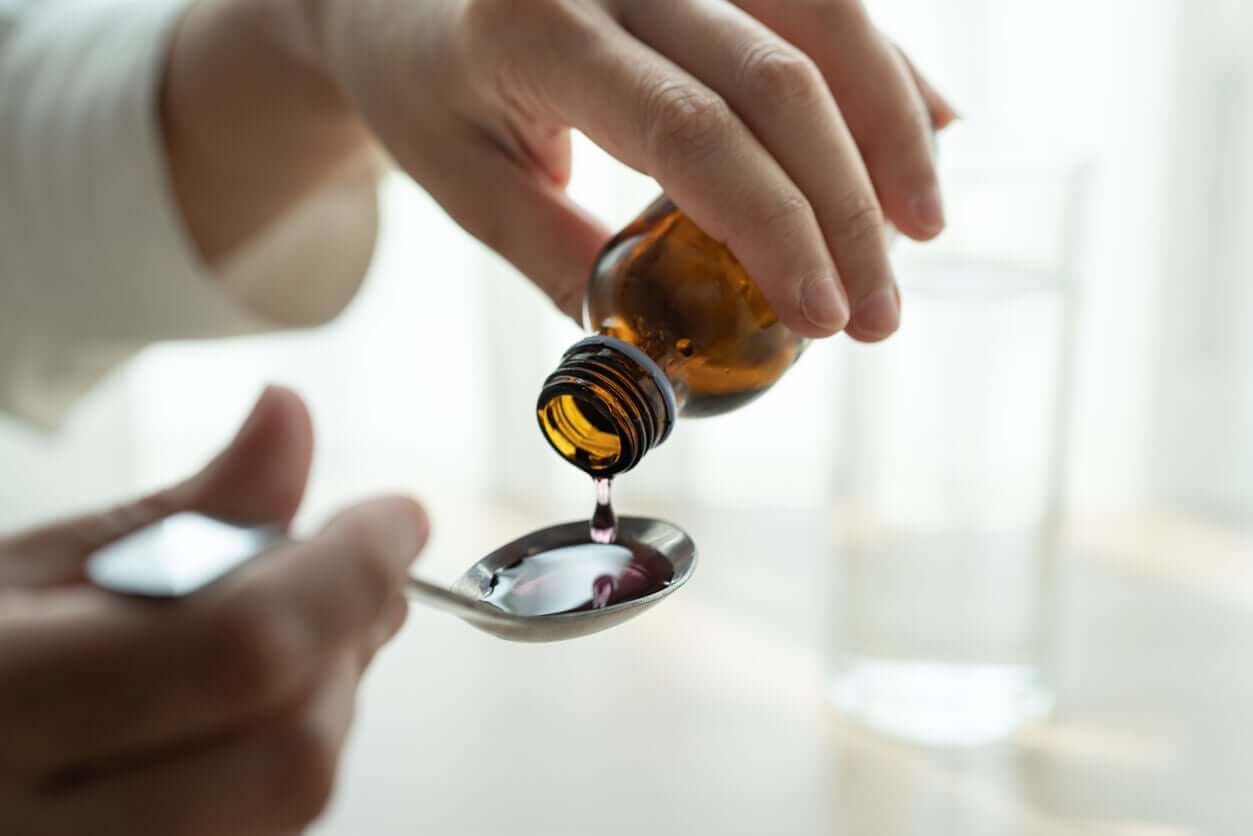Vicks VapoRub®: Pediatricians Don't Recommend It for Children


Written and verified by the nurse Leidy Mora Molina
It’s a well-known fact that children are more sensitive than adults to certain foods and medications. For this reason, one must be very cautious with what we offer them and how we go about it. One of the most widely used drug products in the winter is Vicks VapoRub®, a menthol ointment that provides relief from cold symptoms. Its use in children is controversial, as many pediatricians don’t recommend it at all. Do you want to know why? Let’s take a look in the following article.
What is Vicks VapoRub® and when is it used?
As we’ve mentioned, Vicks VapoRub® is a well-known product used in homes to combat cold symptoms and some other ailments.
It’s a topical medicine, which is applied to the skin of the chest so that its vapors enter through the respiratory tract. The desired effect is to relieve cough, promote the expectoration of mucus, and improve nasal congestion. Some people also use it to relieve muscle aches.
Among the components of the Vicks VapoRub®, the following stand out:
- Camphor
- Eucalyptus oil
- Menthol
- Other Ingredients: Cedar Leaf Oil, Nutmeg Oil, Vaseline, Thymol, and Turpentine Oil
Due to the substances that it contains, the use of this product isn’t recommended in children under 2 years of age. This warning is on the packaging, but still many people ignore this text and use it on babies and young children. It should be noted that pediatricians don’t recommend its use in children of any age.
Why is the use of Vicks VapoRub® considered dangerous in children?
As we’ve mentioned, the components of this product aren’t considered safe for use in infants and children. Next, we’ll tell you the reasons.
And increased risk of poisoning
Camphor, menthol, eucalyptus, and turpentine are highly toxic components for children.
Some of them are toxic in case of accidental ingestion, while others are harmful if they’re simply inhaled or absorbed through the infant’s skin. This is particularly important in babies and young children.
There are many recorded cases of camphor poisoning in children and some have had fatal consequences.
The symptoms of poisoning by the components of Vicks VapoRub®, both orally or inhaled, are the following:
- Vomiting and diarrhea
- Headache
- Disorientation
- Seizure
- Sensory alterations (go from irritability to sleep in short periods of time)
- Respiratory insufficiency
- Coma
Similarly, its use during lactation is discouraged, as camphor and menthol can cause toxic effects in the infant.

Inflammation of the airways and increased mucus production
Although Vicks VapoRub® is marketed as a decongestant and antitussive medicine (which relieves cough), in children, it can cause the opposite effect. This is because its components are capable of triggering a hypersensitivity reaction in the airways, which leads to them becoming even more inflamed and producing a greater amount of mucus.
This effect is more common in children under 2 years of age or in children with a history of asthma or bronchospasm.
According to an American study published in the journal Chest, the closer to the nose the Vicks VapoRub® is placed in children, the greater the chances of causing such a respiratory episode.
The researchers highlighted that this product can induce inflammation of the lower respiratory tract, which causes a worsening of the initial congestive condition.
It affects the skin and mucous membranes of infants
As we well know, children have very sensitive skin to external agents. Therefore, when in contact with the components of the Vicks VapoRub®, a marked reddening of the area is triggered, which can lead to allergies and dermatitis.
Similarly, its components can come into contact with the eyes, causing irritation of the mucous membranes and keratoconjunctivitis. Cases of corneal damage caused by direct contact with this drug have even been recorded.
What are safe options for relieving cold symptoms in children?
If your little one has a cough or nasal congestion, it’s best to have them evaluated by a doctor to determine the best treatment to follow.
In the event that they’re very congested and you want to help it alleviate these symptoms, you can take into account the following recommendations from specialists:
- Perform nasal washes with sterile physiological saline or sterile seawater. These procedures can be performed whenever necessary, and with a good technique, they don’t usually bring side effects in the child.
- Use room humidifiers. Ideally, you shouldn’t leave them overnight in babies’ and toddlers’ rooms.
- Offer steam baths to relieve nasal congestion.
- Use a nasal aspirator to collect the mucus.
- Keep your child hydrated, as this helps to thin the secretions and eliminate them better.
Along with this, it should be noted that the United States Food and Drug Administration (the FDA) doesn’t recommend the use of over-the-counter medications for cough relief (antitussives) in children under four years of age. This is because the components of these drugs can be very toxic in an accidental overdose.

Before offering Vicks VapoRub® to your child, check with your doctor!
As you can see, it’s not a good idea to use any medication in children without the approval of their pediatrician, no matter what health condition they present.
If you have questions about the use, dosage, and administration of any drug or natural remedy, don’t hesitate to consult with a health professional before administering it to your child.
It’s a well-known fact that children are more sensitive than adults to certain foods and medications. For this reason, one must be very cautious with what we offer them and how we go about it. One of the most widely used drug products in the winter is Vicks VapoRub®, a menthol ointment that provides relief from cold symptoms. Its use in children is controversial, as many pediatricians don’t recommend it at all. Do you want to know why? Let’s take a look in the following article.
What is Vicks VapoRub® and when is it used?
As we’ve mentioned, Vicks VapoRub® is a well-known product used in homes to combat cold symptoms and some other ailments.
It’s a topical medicine, which is applied to the skin of the chest so that its vapors enter through the respiratory tract. The desired effect is to relieve cough, promote the expectoration of mucus, and improve nasal congestion. Some people also use it to relieve muscle aches.
Among the components of the Vicks VapoRub®, the following stand out:
- Camphor
- Eucalyptus oil
- Menthol
- Other Ingredients: Cedar Leaf Oil, Nutmeg Oil, Vaseline, Thymol, and Turpentine Oil
Due to the substances that it contains, the use of this product isn’t recommended in children under 2 years of age. This warning is on the packaging, but still many people ignore this text and use it on babies and young children. It should be noted that pediatricians don’t recommend its use in children of any age.
Why is the use of Vicks VapoRub® considered dangerous in children?
As we’ve mentioned, the components of this product aren’t considered safe for use in infants and children. Next, we’ll tell you the reasons.
And increased risk of poisoning
Camphor, menthol, eucalyptus, and turpentine are highly toxic components for children.
Some of them are toxic in case of accidental ingestion, while others are harmful if they’re simply inhaled or absorbed through the infant’s skin. This is particularly important in babies and young children.
There are many recorded cases of camphor poisoning in children and some have had fatal consequences.
The symptoms of poisoning by the components of Vicks VapoRub®, both orally or inhaled, are the following:
- Vomiting and diarrhea
- Headache
- Disorientation
- Seizure
- Sensory alterations (go from irritability to sleep in short periods of time)
- Respiratory insufficiency
- Coma
Similarly, its use during lactation is discouraged, as camphor and menthol can cause toxic effects in the infant.

Inflammation of the airways and increased mucus production
Although Vicks VapoRub® is marketed as a decongestant and antitussive medicine (which relieves cough), in children, it can cause the opposite effect. This is because its components are capable of triggering a hypersensitivity reaction in the airways, which leads to them becoming even more inflamed and producing a greater amount of mucus.
This effect is more common in children under 2 years of age or in children with a history of asthma or bronchospasm.
According to an American study published in the journal Chest, the closer to the nose the Vicks VapoRub® is placed in children, the greater the chances of causing such a respiratory episode.
The researchers highlighted that this product can induce inflammation of the lower respiratory tract, which causes a worsening of the initial congestive condition.
It affects the skin and mucous membranes of infants
As we well know, children have very sensitive skin to external agents. Therefore, when in contact with the components of the Vicks VapoRub®, a marked reddening of the area is triggered, which can lead to allergies and dermatitis.
Similarly, its components can come into contact with the eyes, causing irritation of the mucous membranes and keratoconjunctivitis. Cases of corneal damage caused by direct contact with this drug have even been recorded.
What are safe options for relieving cold symptoms in children?
If your little one has a cough or nasal congestion, it’s best to have them evaluated by a doctor to determine the best treatment to follow.
In the event that they’re very congested and you want to help it alleviate these symptoms, you can take into account the following recommendations from specialists:
- Perform nasal washes with sterile physiological saline or sterile seawater. These procedures can be performed whenever necessary, and with a good technique, they don’t usually bring side effects in the child.
- Use room humidifiers. Ideally, you shouldn’t leave them overnight in babies’ and toddlers’ rooms.
- Offer steam baths to relieve nasal congestion.
- Use a nasal aspirator to collect the mucus.
- Keep your child hydrated, as this helps to thin the secretions and eliminate them better.
Along with this, it should be noted that the United States Food and Drug Administration (the FDA) doesn’t recommend the use of over-the-counter medications for cough relief (antitussives) in children under four years of age. This is because the components of these drugs can be very toxic in an accidental overdose.

Before offering Vicks VapoRub® to your child, check with your doctor!
As you can see, it’s not a good idea to use any medication in children without the approval of their pediatrician, no matter what health condition they present.
If you have questions about the use, dosage, and administration of any drug or natural remedy, don’t hesitate to consult with a health professional before administering it to your child.
All cited sources were thoroughly reviewed by our team to ensure their quality, reliability, currency, and validity. The bibliography of this article was considered reliable and of academic or scientific accuracy.
- Agencia española de medicamentos y productos sanitarios (2018). Ficha técnica: Vicks Vaporub. Recuperado de: https://cima.aemps.es/cima/pdfs/es/ft/22051/FT_22051.pdf
- Lomparte, C. (2002). Intoxicación por alcanfor: una breve revisión, a propósito de dos casos probables. Revista Paediatrica 2002; 4 (2) : 54 – 58
- Mintegi, S. (2012). Manual de intoxicaciones en Pediatría. España. 3ª edición.
- New Jersey department of healt and senior services (2005). Hoja informativa sobre sustancias peligrosas. Alcanfor. Recuperado de: https://www.nj.gov/health/eoh/rtkweb/documents/fs/0334sp.pdf
- AEP – Asociación Española de Pediatría. (2011). Decálogo de la tos. [Internet] Acceso enero 2022. Disponible en: https://www.aepap.org/sites/default/files/documento/archivos-adjuntos/decalogo_tos.pdf
This text is provided for informational purposes only and does not replace consultation with a professional. If in doubt, consult your specialist.








